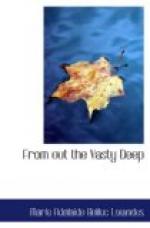On the other side of the host sat Helen Brabazon.
Blanche looked at the late Mrs. Varick’s one intimate friend with critical interest. Yes, Miss Brabazon looked Somebody, though a somewhat old-fashioned Somebody, considering that she was still quite a young woman. She had good hair, a good complexion, and clear, honest-looking hazel eyes; but not her kindest friends would have called her pretty. What charm she had depended on her look of perfect health, and her alert, intelligent expression of face. Miss Farrow, who was well read, and, indeed, had a fine taste in literature, told herself suddenly that Miss Brabazon was rather her idea of Jane Austen’s Emma! Her dark-blue velvet dress, though it set off her pretty skin, and the complexion which was one of her best points, yet was absurdly old, for a girl. Doubtless Miss Brabazon’s gown had been designed by the same dressmaker who had made her mother’s presentation dress some thirty years before. Such dressmakers are a quaint survival of the Victorian age, and to them old-fashioned people keep on going from a sense of loyalty, or perhaps because they are honestly ignorant of what strides in beauty and elegance other dressmakers have made in the last quarter of a century.
The hostess’s eye travelled slowly round the table. How ludicrous the contrast between Helen Brabazon and Bubbles Dunster! Yet they were probably very much of an age. Bubbles, who looked such a child, must now be—yes, not far from two-and-twenty.
Miss Farrow checked a sigh. She had been twenty-one herself—but what a charming, distinguished, delightful twenty-one—when she had formed one of a little group round the font of St. Peter’s, Eaton Square. She remembered what an ugly baby she had thought Bubbles, and how she had been anything but pleased when someone present facetiously observed that god-mother and godchild had very much the same type of nose and ears and mouth!
To-night Bubbles was wearing an eccentric, and yet very becoming garment. To the uninitiated it might have appeared fashioned out of an old-fashioned chintz curtain. As a matter of fact, the intricate flower pattern with which it was covered had been copied on a Lyons loom from one of those eighteenth century embroidered waistcoats which are rightly prized by connoisseurs. The dress was cut daringly low, back and front, especially back, and the girl wore no jewels. But through her “bobbed” hair was tucked a brilliant little silk flag, which carried out and emphasized the colouring of the flowers scattered over the pale pink silk of which its wearer’s gown was made.
Bubbles, in that staid and decorous company, looked as if she had wandered in from some gay Venetian masquerade.
She was now sitting between the millionaire, James Tapster, and her own friend, Bill Donnington. When she had heard that she had been placed next Donnington, Bubbles had pouted. “I’d rather have had Sir Lyon,” she exclaimed, “or even the old ’un!”—for so she irreverently designated Helen Brabazon’s uncle, Mr. Burnaby.




